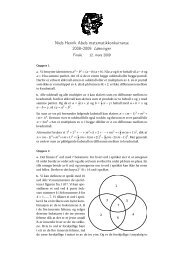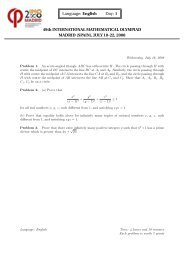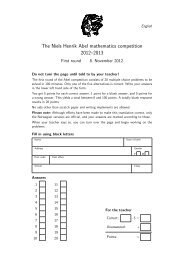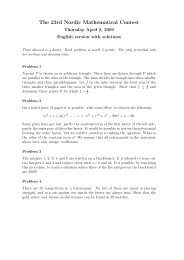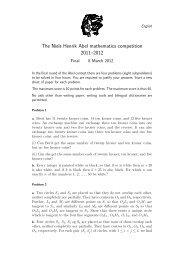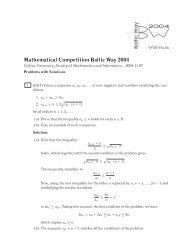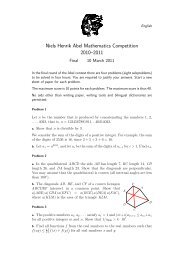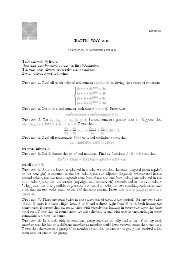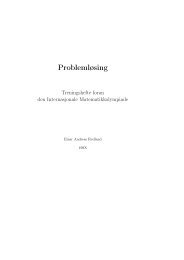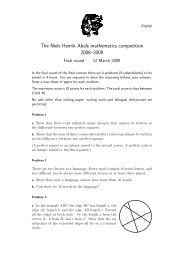Solutions - Georg Mohr-Konkurrencen
Solutions - Georg Mohr-Konkurrencen
Solutions - Georg Mohr-Konkurrencen
- No tags were found...
You also want an ePaper? Increase the reach of your titles
YUMPU automatically turns print PDFs into web optimized ePapers that Google loves.
By (5),a 2 i−1ia i a i−2 i − 1 = 1 + 1i − 1 > 1 + 1 i = i + 1 ,iwhich impliesi · y 2 · a 2 i−1 > (i + 1) · y 2 · a i a i−2 . (8)Multiplying (5) and (6), and dividing both sides of the resulting inequalityby ia i a i−1 , we get(i − 1) · a i a i−1 (i + 1) · a i+1 a i−2 .Adding (i + 1)a i a i−1 to both sides of the last inequality and multiplyingboth sides of the resulting inequality by xy givesi · 2xy · a i a i−1 (i + 1) · xy · (a i+1 a i−2 + a i a i−1 ) . (9)Finally, adding up (7), (8) and (9) results ini · (xa i + ya i−1 ) 2 > (i + 1) · (xa i+1 + ya i )(xa i−1 + ya i−2 ) ,which is equivalent to the claim.16. Answer: 2.For any prime p we have f(p) = f(1) − f(p) and thus f(p) = f(1)2 .If n is a product of two primes p and q , then f(n) = f(p) − f(q) orf(n) = f(q) − f(p), so f(n) = 0. By the same reasoning we find that if nis a product of three primes, then there is a prime p such that( n)f(n) = f − f(p) = −f(p) = − f(1) .p 2By simple induction we can show that if n is the product of k primes,then f(n) = (2 − k) · f(1) . In particular, f(2001) = f(3 · 23 · 29) = 1 so2f(1) = −2. Therefore, f(2002) = f(2 · 7 · 11 · 13) = −f(1) = 2.17. We choose the numbers 1, 3, 5, . . . , 2 n − 1 and 2, 4, 8, 16, . . . , 2 n , i.e. allodd numbers and all powers of 2. Consider the three possible cases.11



